![]()
![]()
![]()
Use LEFT and RIGHT arrow keys to navigate between flashcards;
Use UP and DOWN arrow keys to flip the card;
H to show hint;
A reads text to speech;
31 Cards in this Set
- Front
- Back
|
Genomics |
Study of whole sets of genes and their interactions |
|
|
Bioinformatics |
Application of computational methods to the storage and analysis of biological data |
|
|
Human genome project |
Started in 1990 and completed in 2003 Used whole genome shotgun approach and dideoxy chain termination method Technology for faster sequencing |
|
|
Whole genome shotgun approach |
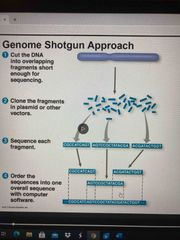
O |
|
|
Metagenomics |
DNA from a group of species in an environmental sample is sequenced Making sense of massive amounts of data from many genome sequences has started new approaches ie: get sample of gut bacteria and find out what’s there |
|
|
Gene annotation |
The identification of protein-coding genes within DNA sequences in a database Largely an automated process Comparing sequences of previously unknown genes with those of known genes may help provide clues about their function |
|
|
Proteome |
Entire set of proteins expressed by a cell or group of cells |
|
|
Proteomics |
Approach to studying large sets of proteins and their properties |
|
|
Systems biology |
Genes and proteins and their function integration in bio systems |
|
|
Application of systems biology to medicine |
Cancer genome atlas: comparing gene sequences and expression in cancer vs normal cells (ten types of cancers) Gene chip is used to understand gene expression patterns in cancer patients |
|
|
Genome size |
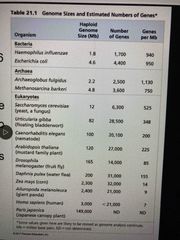
There is no systematic relationship btw genome size and phenotype Eukaryotic genomes tend to be larger Genomes of most bacteria and archaea range from 1-6 million |
|
|
Number of genes |
Not correlated to genome size Drosophila has 165 Mb and 14,000 genes Humans have fewer than 21,000 (same as a worm) which is far off from what was predicted: 50,000-100,000 |
|
|
Transposons |
Require enzyme, trabsposase to move by mean of DNA intermediate Cut/paste or copy/paste like |
|
|
Gene density and noncoding DNA |
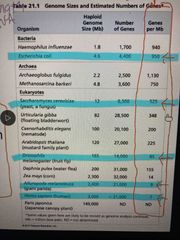
Number of genes per given DNA= density Humans have lowest gene density in length of DNA or mega base (mb) Eukaryotes Have many introns within genes and a large amount of noncoding DNA btw genes |
|
|
Noncoding DNA-a lot of it |

98.5% of human genome does not code for proteins Gene regulatory sequences and introns account for 5% and 20% respectively |
|
|
L1 sequences |
Retrotransposons Low rate of transposition and may effect gene expression May play role in diversity of neuronal cell types Do not see these until higher order animals like primates |
|
|
Pseudogenes |
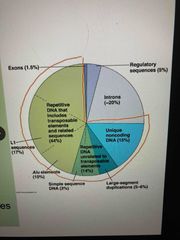
Former genes Accumulated mutations and no longer function A part of unique noncoding dna-15% ie: like old abandon house |
|
|
Multigene families |
Collection of two or more identical or very similar genes 1. Identical DNA sequences usually clustered tandemly (code for rRNA) 2. Nonidentical genes |
|
|
What underlies much of genome evolution? |
Mutations Earliest forms of life likely had only those genes needed for survival and reproduction Size of genomes has increased over time providing gene diversification |
|
|
Polploidy |
Extra set of chromosomes Accidents in meiosis can lead to this Can lead to divergence of sets by accumulating mutations Genes with novel functions can survive |
|
|
Alterations of chromosomes structure |
Humans have 23 chromosomes, while chimps have 24 bit pir chromosomes are similar so at some point separated from same ancestor Duplications and inversions result from mistakes during meiotic recombination |
|
|
Transposons |

Require enzyme, trabsposase to move by mean of DNA intermediate Cut/paste or copy/paste like |
|
|
Retrotransposons |
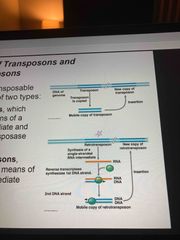
Move by means of RNA intermediate Uses a reverse transcriptase enzyme (takes RNA and reads it back to make DNA) |
|
|
Alu elements |
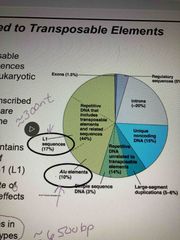
Transcribed into RNA molecules May play a role in gene regulation |
|
|
L1 sequences |
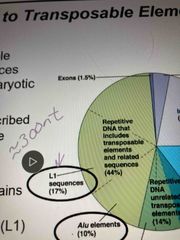
Retrotransposons Low rate of transposition and may effect gene expression May play role in diversity of neuronal cell types Do not see these until higher order animals like primates |
|
|
Other repetitive DNA |
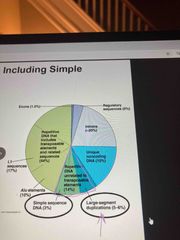
About 5-6% of human genome consist of duplication long sequences of DNA from one location to another In contrast, simple sequence DNA contains many copies of tandemly repeated short sequences |
|
|
Multigene families |
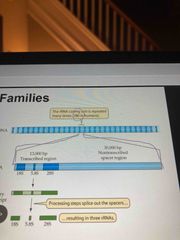
Collection of two or more identical or very similar genes 1. Identical DNA sequences usually clustered tandemly (code for rRNA) 2. Nonidentical genes |
|
|
Junk DNA |
The DNA that does not code for proteins Play important role due to having high level of sequence suggesting that they would have not survived evolution if they didn’t have a role |
|
|
Transposable elements |
Stretched of DNA that can move from on location to another within the genome Jumping genes About 75% of human repetitive DNA is made of these |
|
|
Alterations of chromosomes structure |
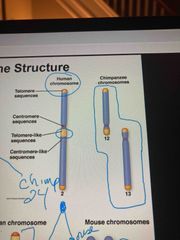
Humans have 23 chromosomes, while chimps have 24 bit pir chromosomes are similar so at some point separated from same ancestor Duplications and inversions result from mistakes during meiotic recombination |
|
|
Eukaryotic transposable elements 2 types |
Transposons and retrotransposons |

